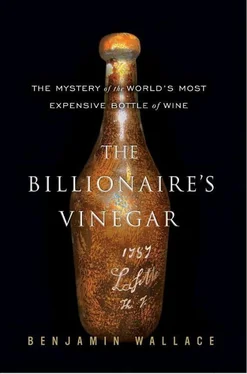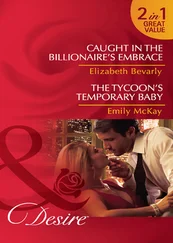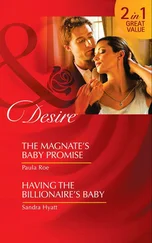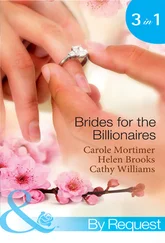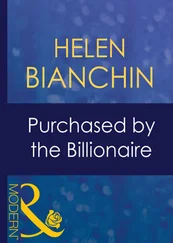Since that time, Koch had patched things up with his brothers, or at least one of them, and had come into his own with a long-shot victory in the America’s Cup in 1992. He owned a privately held energy company called Oxbow, which was a major trader of petroleum coke as well as being the operator of a low-sulfur coal mine in Colorado. He divided his time mainly between homes on Cape Cod and in Palm Beach.
Koch was as passionate as ever about wine. Despite having pruned his cellar by 3,400 bottles through a 1999 sale at Christie’s New York, Koch now owned about 35,000 bottles. It was one of the largest collections in the world. The bottles had cost him $12 million, a lot in wine terms, but a fraction of the $30 million he had paid for the Modigliani above his fireplace, which was just one of many expensive works of art he owned. He bought both broadly (more than 1,400 different wines) and deeply: 60 percent of his wine was Bordeaux, and 35 percent Burgundy. He bought favored wines in quantity, including eight cases and thirty magnums of Latour 1961, and ten cases of 1945 Mouton, and he served $500-a-bottle 1996 Latour at his third wedding. In the glossy coffee-table book published to accompany the Boston MFA show, Koch explained “why I love great wine so much. Not only does it taste beautiful and wonderful and makes you feel great when you’re drinking it—you can also really taste the love the vintner had in making the wine, which is an art form.”
Koch could sometimes seem unserious about the collection. He bought just about any new book on wine, while admitting that he hadn’t read many of them. He liked to take out his bottles and show them off, and once, after producing his Jefferson bottles for a visitor’s benefit, he clinked one against another, chipping off part of the wax seal. “Oh shit!” he said. “Dammit. Oh, c’est la vie. They can fix it.” In the summer of 2000, he and his then-wife saw a couples therapist to discuss his drinking. The New York Post reported that in Palm Beach Koch had openly talked about checking into rehab. He had since remarried.
But his interest in wine went beyond the usual rich man’s accumulation. When buying at auction, Koch often placed the phone bids himself. In 1991, when he was gunning for the America’s Cup, he relocated his wine collection with him to San Diego during trials. Not long after buying the first of his Jefferson bottles from the Chicago Wine Company, Koch had invested $1 million in the firm. He had a bathroom in his house decorated with corks, labels, case ends, and bottle bases from much of the wine he had drunk. And his enthusiasm for wine colored other of his collections: He owned a Greek drinking cup from 470 BC, as well as a marble head of Dionysus.
He also attended wine events, such as the exclusive 2000 Christie’s tasting in New York, a Latour vertical, where he had his one encounter with Rodenstock. He recalled the encounter as having been limited to his saying hello and nodding. (He had been seated next to Matt Dillon, the actor, but then Dillon moved away. Koch remembered this self-deprecatingly, as if Dillon had found him wanting in some way.)
Koch had obtained a Ph.D. in chemical engineering from the Massachusetts Institute of Technology. To win the America’s Cup, he had spent $68 million and hired a team of MIT scientists to build a better boat—with lighter sails, a sleeker hull, and a more hydrodynamic keel. He brought the same rationalistic, free-spending approach to wine. In 1996 he installed a $10,000 state-of-the-art computer system in his 1,750-square-foot primary cellar in Cape Cod. He could walk into his cellar, choose a wine using the touch screen, and get a printout of a map showing exactly where in the cellar to find a particular bottle. A bar code was affixed to every bottle, and as Koch exited the cellar with a bottle in hand, he could swipe it past a scanner, which would automatically update his digitized inventory. Similarly, when decanting older wines, Koch eschewed the traditional candle in favor of using laboratory equipment—including a vacuum pump and a chemical filter. Many connoisseurs consider such filtering anathema, on the theory that it can strip wine of essential qualities, but Koch didn’t buy that argument.
By 2005, 20,000 of his bottles had moved with Koch to Palm Beach, where he had purchased a 36,000-square-foot oceanfront mansion. The new 1,300-square-foot cellar, designed by an Austrian architect and completed in 2001, seemed styled after a European castle—full of salvaged-brick vaults, iron grillwork, Roman mosaics, and candelabra. Sixteen years after Koch had first bought them, the seven eighteenth-century, Rodenstock-sourced bottles remained the centerpiece of his wine collection, and his new Palm Beach cellar included a mirror-backed cage to showcase them.
Though in person he could come off as folksy, awkward, and even shy, few wine collectors of Koch’s magnitude were as publicly proud of their holdings. The show “Things I Love: The Many Collections of William I. Koch,” which opened in Boston on August 31, 2005, promised to include at least one of the four Jefferson bottles. The coffee-table book produced to accompany the show, its covers lined with a photo collage of trophy-wine labels from Koch’s collection, contained images not only of that quartet—Lafite and Mouton, in both 1784 and 1787 vintages—but also of his three other eighteenth-century vintages of Lafite (1737 and 1771) and Latour (1791).
A visitor wandering through the exhibit, expecting to see the bottles, came first upon Koch’s collection of miniature models of every boat that had won or lost the America’s Cup. There were Sitting Bull’s bead belt and breastpiece, Custer’s hunting rifle, and the revolver that killed Jesse James. There were Impressionist paintings, sculptures by Rodin and Botero, and ancient coins. As Koch put it, “My brother Charles collects money. David used to collect girls, but not anymore. Fred collects castles. And I collect everything.”
The wine, or rather the wine bottles, were displayed in the low-lit, high-ceilinged Torf Gallery. There were ten of them, all empty, ranging from an 1865 Latour to a 1921 Pétrus in a big bottle to a Nebuchadnezzar inscribed “America’s Foundation/America’s Cup 1992.” A caption, painted in white on the gray wall in the glass case, announced: “With more than thirty thousand bottles, Bill Koch’s wine collection includes Château Pétrus, Château Latour, and Château Mouton, just to name a few. He is particularly proud of bottles of Mouton and Lafite thought to have been purchased in France by Thomas Jefferson. Some of Koch’s life accomplishments, such as the victory of America 3in 1992, have been commemorated by specifically designed bottles.”
Strangely, the Jefferson bottles were nowhere to be seen.
CHAPTER 18

GHOST PARTICLES
PROUD AS BILL KOCH WAS OF HIS JEFFERSON bottles, he had grown increasingly concerned about their provenance. During the same period when Koch was assembling the verticals that anchored his wine cellar, he had had a fateful experience involving some rare coins. It began in 1984, when, flush with his buyout money, he acquired for $3.2 million what were believed to be the rarest coins ever found: 1,700 ancient Greek pieces, including thirteen silver decadrachms, in a clay pot unearthed by three prospectors in a field in southern Turkey. Koch thought he could make an easy profit by selling some of the coins, while still retaining the greatest hoard in the world.
Even before Koch bought the coins, there were clues that the Turkish government might be looking for them. (Turkish authorities had been tipped off to the find after one of the peasant treasure finders “bought a Mercedes or did something similarly intelligent,” according to a warning letter sent by a Swiss coin dealer to the Boston MFA classical-art curator who was authenticating the coins for Koch.) In a move he would later regret, Koch satisfied himself with warranties from the Turkish and German dealers that the coins were unencumbered. After a decade-long legal fight with the Turkish government, Koch settled, returning the coins to Turkey in exchange for a plaque to be displayed with them, thanking him.
Читать дальше
